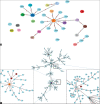Prevalence and multidrug-resistant profile of methicillin-resistant Staphylococcus aureus and methicillin-resistant Staphylococcus pseudintermedius in dogs, cats, and pet owners in Malaysia
- PMID: 37041832
- PMCID: PMC10082735
- DOI: 10.14202/vetworld.2023.536-545
Prevalence and multidrug-resistant profile of methicillin-resistant Staphylococcus aureus and methicillin-resistant Staphylococcus pseudintermedius in dogs, cats, and pet owners in Malaysia
Abstract
Background and aim: Staphylococcus aureus and Staphylococcus pseudintermedius are widespread skin and mucous membrane colonizers and may cause opportunistic infections in humans and animals. This study aimed to identify and characterize methicillin-resistant S. aureus (MRSA) and methicillin-resistant S. pseudintermedius (MRSP) isolates from domestic and stray dogs and cats and pet owners in Malaysia using molecular epidemiology and antimicrobial profiling.
Materials and methods: Three hundred and fifty oral and nasal swabs were taken from pet and stray dogs and cats and pet owners; all samples were subjected to culture and biochemical tests and polymerase chain reaction; the selected isolates were put through disk diffusion test and multilocus sequence typing.
Results: One S. aureus isolate and three S. pseudintermedius isolates were identified as MRSA and MRSP, respectively, of which the MRSA isolate and one of the MRSP isolates showed multidrug resistance and the remaining two MRSP isolates were resistant to one or two antimicrobials. Multilocus sequence typing showed that the MRSA isolate belongs to clonal complex (CC) 789, while for the MRSP isolates, two were in CC45 and one was a singleton.
Conclusion: This study is the first study in Malaysia to perform molecular characterization of MRSP isolated from pet dogs and cats and pet owners. The outcomes of this study reveal that even healthy pet dogs and cats and their owners can be carriers of drug-resistant staphylococci, highlighting the role of pets and pet owners as carriers of MRSA and MRSP in Malaysia.
Keywords: antimicrobial resistance; antimicrobial susceptibility testing; methicillin resistance; multilocus sequence typing; public health; zoonotic infections.
Copyright: © Afshar, et al.
Conflict of interest statement
The authors declare that they have no competing interests.
Figures



Similar articles
-
Genetic characterisation of methicillin-resistant Staphylococcus aureus and Staphylococcus pseudintermedius in pets and veterinary personnel in Iran: new insights into emerging methicillin-resistant S. pseudintermedius (MRSP).J Glob Antimicrob Resist. 2019 Mar;16:6-10. doi: 10.1016/j.jgar.2018.08.022. Epub 2018 Aug 30. J Glob Antimicrob Resist. 2019. PMID: 30172831
-
Nasal Staphylococcus aureus and S. pseudintermedius carriage in healthy dogs and cats: a systematic review of their antibiotic resistance, virulence and genetic lineages of zoonotic relevance.J Appl Microbiol. 2022 Dec;133(6):3368-3390. doi: 10.1111/jam.15803. Epub 2022 Sep 27. J Appl Microbiol. 2022. PMID: 36063061 Free PMC article.
-
Epidemiologic case investigation on the zoonotic transmission of Methicillin-resistant Staphylococcus pseudintermedius among dogs and their owners.J Infect Public Health. 2023 Dec;16 Suppl 1(Suppl 1):183-189. doi: 10.1016/j.jiph.2023.10.041. Epub 2023 Nov 3. J Infect Public Health. 2023. PMID: 37973497 Free PMC article.
-
High diversity of Staphylococcus aureus and Staphylococcus pseudintermedius lineages and toxigenic traits in healthy pet-owning household members. Underestimating normal household contact?Comp Immunol Microbiol Infect Dis. 2013 Jan;36(1):83-94. doi: 10.1016/j.cimid.2012.10.001. Epub 2012 Nov 13. Comp Immunol Microbiol Infect Dis. 2013. PMID: 23153600
-
Systematic Review on Global Epidemiology of Methicillin-Resistant Staphylococcus pseudintermedius: Inference of Population Structure from Multilocus Sequence Typing Data.Front Microbiol. 2016 Oct 18;7:1599. doi: 10.3389/fmicb.2016.01599. eCollection 2016. Front Microbiol. 2016. PMID: 27803691 Free PMC article. Review.
Cited by
-
Rhodomyrtone-rich fractions from Rhodomyrtus tomentosa (Aiton) Hassk. leaves: A potent antimicrobial compound for Staphylococcus pseudintermedius.Vet World. 2025 Apr;18(4):1025-1035. doi: 10.14202/vetworld.2025.1025-1035. Epub 2025 Apr 30. Vet World. 2025. PMID: 40453951 Free PMC article.
-
The Diversity and Zoonotic Potential of Staphylococcus pseudintermedius in Humans and Pet Dogs in Trinidad and Tobago.Antibiotics (Basel). 2023 Jul 31;12(8):1266. doi: 10.3390/antibiotics12081266. Antibiotics (Basel). 2023. PMID: 37627686 Free PMC article.
-
Pet Owners' Knowledge of Antibiotic Use and Antimicrobial Resistance and Their Antibiotic Practices: Comparison Between Contexts of Self and Pet.Antibiotics (Basel). 2025 Feb 5;14(2):158. doi: 10.3390/antibiotics14020158. Antibiotics (Basel). 2025. PMID: 40001402 Free PMC article.
References
-
- Gómez-Sanz E, Torres C, Lozano C, Zarazaga M. High diversity of Staphylococcus aureus and Staphylococcus pseudintermedius lineages and toxigenic traits in healthy pet-owning household members. Underestimating normal household contact? Comp. Immunol. Microbiol. Infect. Dis. 2013;36(1):83–94. - PubMed
-
- Nocera F.P, Meroni G, Fiorito F, De Martino L, Martino P.A. Occurrence and antimicrobial susceptibility of canine Staphylococcus pseudintermedius strains isolated from two different Italian university veterinary hospitals. Vet. Ital. 2020;56(4):263–269. - PubMed
-
- Tamakan H, Gocmen H. Genetic characterization of methicillin-resistant Staphylococcus pseudintermedius in dogs and cats in Cyprus:Comparison of MRSP and MRSA results. Pak. J. Zool. 2022;54(3):1511–1519.
-
- Weese J.S, Van Duijkeren E. Methicillin-resistant Staphylococcus aureus and Staphylococcus pseudintermedius in veterinary medicine. Vet. Microbiol. 2010;140(3–4):418–429. - PubMed
LinkOut - more resources
Full Text Sources
Molecular Biology Databases
Miscellaneous
